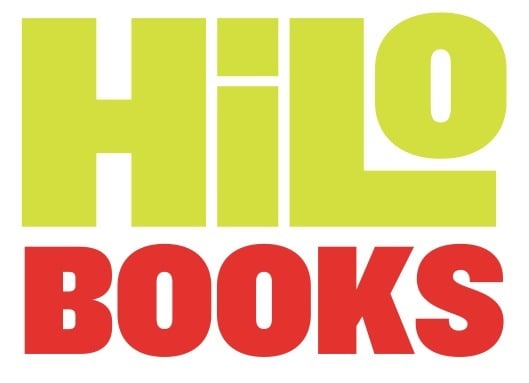
In 2012–2013, HiLoBooks serialized (here at HILOBROW) and reissued ten proto-sf novels from the early twentieth-century era that Josh Glenn named the genre’s Radium Age. Ten years later, Josh started up a similar series for the MIT Press.
- Jack London’s The Scarlet Plague, Introduction by Matthew Battles. “Not just among the first modern post-apocalyptic fictions — starting right about now, a global contagion wipes out nearly all 8 billion earthlings,” says Kurt Andersen. “But maybe the most Edenic and winsome one ever.”
- Rudyard Kipling’s With the Night Mail and “As Easy as A.B.C.”, Introduction by Matthew De Abaitua and Afterword by Bruce Sterling. “An amazing tour-de-force of inspired genius,” says Bruce Sterling. “Kipling, in 1905, is doing things that science fiction as a genre wouldn’t achieve until Robert Heinlein arrived in the late 1940s.”
- Arthur Conan Doyle’s The Poison Belt, Introduction by Joshua Glenn and Afterword by Gordon Dahlquist. “It’s impossible to read The Poison Belt, written in 1913,” says Gordon Dahlquist, “and not see in its exterminating vision a shadow of the coming war that would, only slightly less effectively, destroy Conan Doyle’s world.”
- H. Rider Haggard’s When the World Shook, Introduction by James Parker. “If this is pulp fiction it’s high pulp: a Wagnerian opera of an adventure tale, a B-movie humanist apocalypse and chivalric romance,” says Lydia Millet. “H. Rider Haggard’s rich universe is both profoundly camp and deeply idealistic.”
- Edward Shanks’ The People of the Ruins, Introduction by Tom Hodgkinson. “A very good and a very interesting novel,” says Tom Hodgkinson, which can be read with pleasure both as a curiosity item and for its own sake.”
- William Hope Hodgson’s The Night Land, Introduction by Erik Davis. “For all its flaws and idiosyncracies, The Night Land is utterly unsurpassed, unique, astounding,” says China Miéville. “A mutant vision like nothing else there has ever been.”
- J.D. Beresford’s Goslings, Introduction by Astra Taylor. “At once a postapocalyptic adventure, a comedy of manners, and a tract on sexual and social equality, Goslings is by turns funny, horrifying, and politically stirring,” says Benjamin Kunkel. “Most remarkable of all may be that it has not yet been recognized as a classic.”
- E.V. Odle’s The Clockwork Man, Introduction by Annalee Newitz. “Edwin Vincent Odle’s ominous, droll, and unforgettable The Clockwork Man is a missing link between Lewis Carroll and John Sladek or Philip K. Dick,” says Jonathan Lethem. “Considered with them, it suggests an alternate lineage for SF, springing as much from G.K. Chesterton’s sensibility as from H.G. Wells’s.”
- Cicely Hamilton’s Theodore Savage, Introduction by Gary Panter. “Like Colson Whitehead’s Zone One without the zombie camp and idiom, Theodore Savage is a dark, strange, and cruelly contemporary tale of The Ruin and the post-apocalyptic condition that follows,” says Alexis Madrigal. “The book makes a spirited argument against science and machines, disputing itself viciously to the last word.”
- Muriel Jaeger’s The Man with Six Senses, Introduction by Mark Kingwell. “The first attempt to extrapolate the hypothesis [of ESP] carefully and painstakingly,” says The Encyclopedia of Science Fiction, “and to conclude that it might better be reckoned a curse than a blessing.” OUT OF PRINT
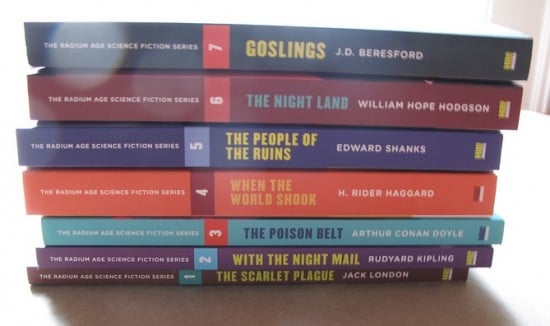
Here are a few nice things said about the Radium Age Science Fiction series:
“We’re extremely excited that the incredible pop culture website HILOBROW is launching its own publishing line, HiLoBooks, to bring us fascinating new serialized fiction and reintroduce the world to the scifi novels of the Radium Age.” — io9
“HiLoBooks, an offshoot of HiLoBrow, will serialize works of ‘radium age’ science fiction on their website, beginning with Jack London’s The Scarlet Plague. (Yes, that Jack London.)” — NPR’s “Science Friday” blog
“Less academic in orientation [than Wesleyan’s “Early Classics of Science Fiction” series] but no less welcome in its efforts at critical salvage, HiLoBooks’s “Radium Age Science Fiction” series, which debuted this year, covers a relatively neglected period in the genre’s history — the three decades between the classic scientific romances of Wells in the late 1890s and the mature pulp era of the 1930s.” — “Salvage Operations,” The Los Angeles Review of Books
“So, now we’ve survived another doomsday prediction, what better way to relax than with visions of the apocalypse from the golden days of vintage SF? And there’s no more stylish way to do it than with the new series of “Radium SF” paperbacks from HiLoBooks. With their vibrant, moody cover art, and discerning selection, these already look as if they’re in collect-the-set territory.” — from the journal WORMWOOD’s blog
“These rare books make great additions for stalwart fans [of Jack London, Arthur Conan Doyle, Rudyard Kipling, et al.], and can give even casual readers a totally different perspective on these writers… A welcome rediscovery.” — from the literary magazine RAIN TAXI
“Now that other publishers have started releasing some of the novels on his best-of list, it seems that Glenn was on the cutting edge of a cultural revival of futuristic tales that are a century old. What’s incredible about looking back on the Radium Age is that you realize so many of the science fiction themes we think of as solidly contemporary — from post-humans and the singularity, to zombie-populated dystopias — actually got their start way back in the early 1900s.” — from the blog Ars Technica
“If the look, feel, and aesthetics of books do not matter to you, go the cheap route with everything — Austen, Dickens, Melville, Twain, Balzac, etc. can be gotten free, all the jewels of literature’s public domain reduced to a black-and-white image clicking past on your computer screen. Fun. But if you want to feel the printed pages, bend the spine, write in the margins, and get the insights of contemporary critics, you can’t do better than a lovingly imagined edition like this, which rediscovers a weird, out-of-time title and presents it in a way that makes sense today. This is the kind of publishing we need more of, not less.” — an Amazon.com user review
“Look. RADIUM AGE sci-fi coming back into print. I didn’t know there was a Radium Age, but I’ve long loved the stories.” — Neil Gaiman tweet
ALSO: In a 2019 Washington Post column, Michael Dirda offered a belated but heartfelt shout-out to HiLoBooks’ The Clockwork Man reissue. Excerpt: “This edition features an excellent introduction by Annalee Newitz…. Is The Clockwork Man serious or slapstick? In fact, it’s both, very much in the manner of H.G. Wells’s comparably serio-comic The Invisible Man and The First Men in the Moon.”
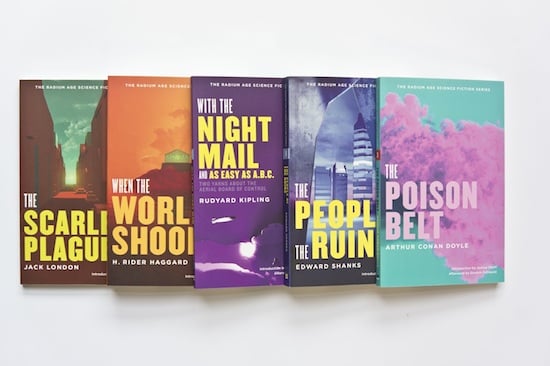
Cover Art: Each of HiLoBooks’ Radium Age titles boasts original cover art by Michael Lewy; and the covers are designed by Tony Leone. Lewy is an artist who subverts PowerPoint, Google Sketchup, Vue, and other corporate software; he is creator of the ongoing multimedia project City of Work, and author of Chart Sensation. NB: Leone and Lewy designed and illustrated the covers of Joshua Glenn’s ’90s zine/journal Hermenaut [below]; HiLoBooks reunited the dream team.
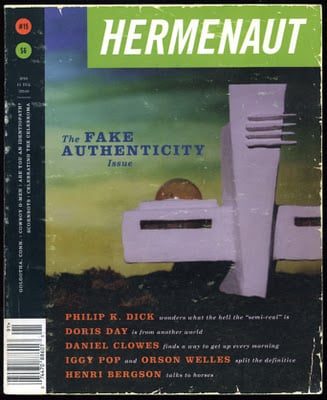
Buzz: Our gratitude, for talking up the HiLoBooks project, goes out to the science fiction blog io9, the technology blog The Verge, the Wall Street Journal blog Ideas Market, NPR’s Science Friday blog, the Believer-published literary blog Believer Logger, The Los Angeles Review of Books, Rocket Ship Pajamas, and the Milwaukee Journal Sentinel’s entertainment blog Tap, among others.
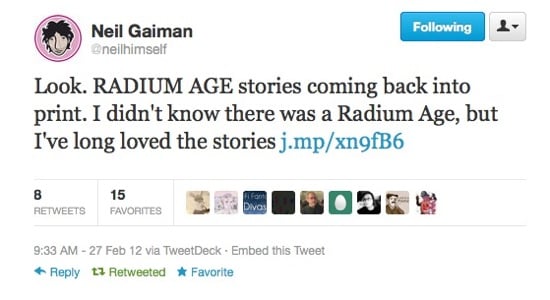
ALSO: See our list of the 100 Best Radium Age Science Fiction Novels.
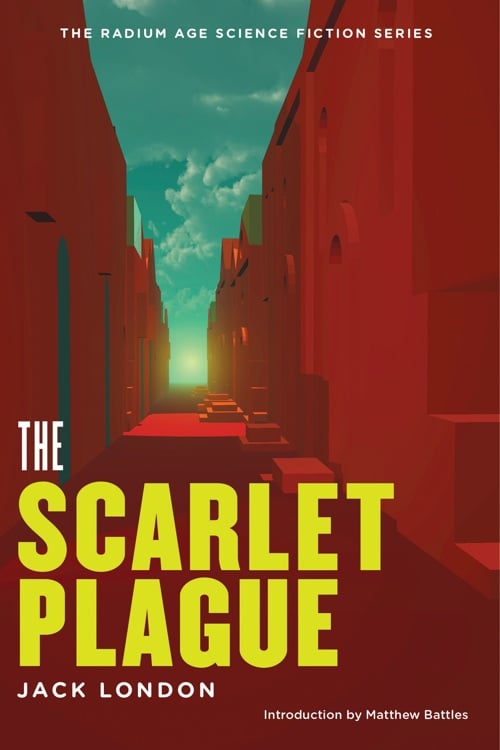
The Scarlet Plague
By Jack London
[ISBN: 978-1-935869-50-4; Library of Congress: 2012930720]
JANUARY — APRIL 2012
Outside the ruins of San Francisco, a former UC Berkeley professor recounts the chilling sequence of events — a gruesome pandemic which killed nearly every living soul on the planet, in a matter of days — which led to his current lowly state. Modern civilization has fallen, and a new race of barbarians, descended from the world’s brutalized workers, has assumed power. Over the space of a few decades, all learning has been lost.
The catastrophe happens in 2013; 2012 marks the centennial of the novel’s first publication.
Jack London, world-famous adventurer and author of The Call of the Wild, wrote several key works of Radium Age science fiction, including The Iron Heel (1908) and The Star Rover (1914). The Scarlet Plague (1912) is set in London’s hometown of San Francisco, California.
“London’s style is typically lush but his viewpoint is skeptical and dystopian … [the] story reminds us of the dangers we still court with our careless ways.” — The Times (1912)
“I knew Jack London was all about romanticizing nature and the frontier and primitive peoples and, you know, the wild. But this showed me a whole new realm of London’s ambivalence about civilization: The Scarlet Plague is not just among the first modern post-apocalyptic fictions — starting right about now, a global contagion wipes out nearly all 8 billion earthlings — but maybe the most Edenic and winsome one ever.” — Kurt Andersen (2012 blurb for HiLoBooks)
“A beautiful edition, proofed and corrected. I would much rather read this than any of the free editions for that reason: I find errors distracting and this version has none.” — Amazon.com user review.
Introduction by Matthew Battles, literary editor of HiLobrow.com and author of Library: An Unquiet History, Letter by Letter, and the science fiction story collection The Sovereignties of Invention.
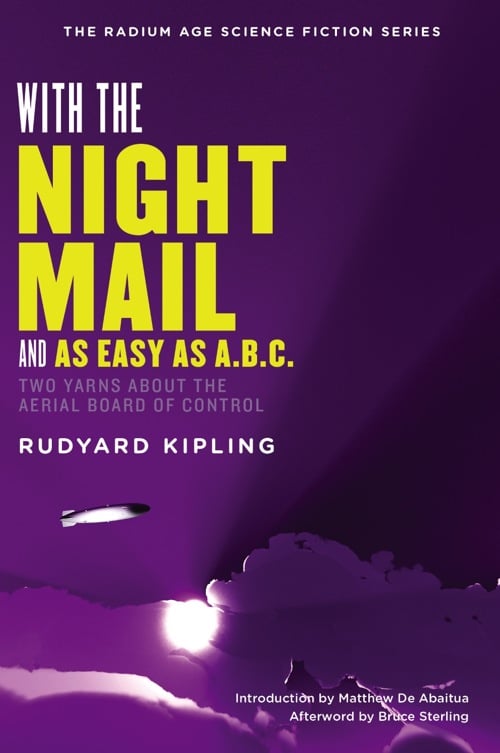
With the Night Mail and “As Easy As A.B.C.”: Two Yarns About the Aerial Board of Control
By Rudyard Kipling
[ISBN: 978-1-935869-52-8; Library of Congress: 2012931028]
MARCH — JUNE 2012
Rudyard Kipling’s With the Night Mail follows the exploits of an intercontinental mail dirigible battling the perfect storm. Between London and Quebec we learn that a planet-wide Aerial Board of Control (A.B.C.) now enforces a technocratic system of command and control not only in the skies but in world affairs. A follow-up story, “As Easy As A.B.C.,” recounts what happens when agitators in Chicago demand the return of democracy.
With the Night Mail is set in 2000, and it first appeared in 1905; 2012 marks the centennial of the first publication of “As Easy As A.B.C.”
Rudyard Kipling was an English poet, prophet of British imperialism, and author of such immortal novels and stories as The Jungle Book, Kim, Just So Stories, and “The Man Who Would Be King.” He also wrote Radium Age science fiction.
“It is a glittering essay in the sham-technical; and real imagination, together with a tremendous play of fancy, is shown in the invention of illustrative detail.” — Arnold Bennett (1917)
“A most remarkable little story… It is rather a fascist picture which Kipling gives us.” — Norbert Weiner, The Human Use of Human Beings (1950)
“An amazing tour-de-force of inspired genius — Kipling, in 1905, is doing things that science fiction as a genre wouldn’t achieve until Robert Heinlein arrived in the late 1940s.” — Bruce Sterling (2012 blurb for HiLoBooks)
Introduction by Matthew De Abaitua, author of the science fiction novel The Red Men, which was shortlisted for the Arthur C. Clarke Award and is being developed for cinema by War Films and Shynola. Afterword by Bruce Sterling, co-founder of science fiction’s cyberpunk movement and blogger at Beyond the Beyond.
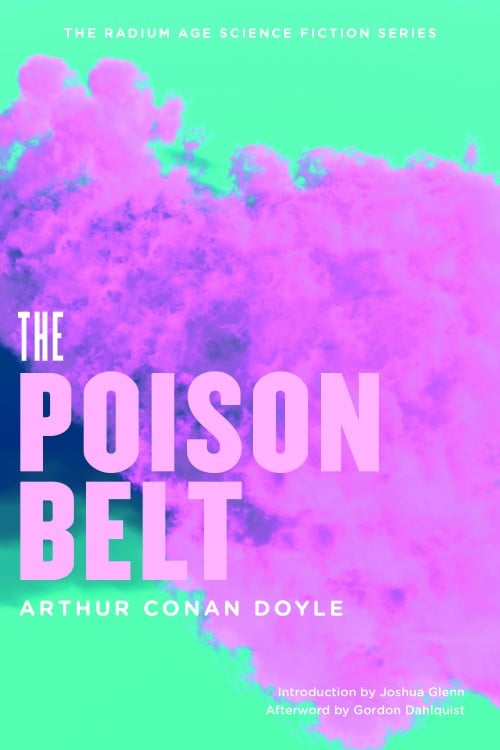
The Poison Belt
By Arthur Conan Doyle
[ISBN: 978-1-935869-54-2; Library of Congress: 2012931029]
APRIL — JULY 2012
If you alone had discovered that the Earth was about to be engulfed in a belt of poisonous “ether” from outer space, what would you do? Professor Challenger, a controversial scientist whose intellectual sprezzatura may remind you of Arthur Conan Doyle’s more famous fictional detective character, assembles the adventurers with whom he’d once romped through a South American jungle (in The Lost World, published in 1912) and locks them in his wife’s dressing room. Less a thriller than a brainteaser set against a catastrophic backdrop, in this 1913 sequel Challenger & Co. inquire into the method of the mind, and the relationship of intuition to reason, even as the world ends.
Arthur Conan Doyle, creator of the legendary detective Sherlock Holmes, also wrote a series of thrilling Radium Age science fiction adventures starring the brilliant, daring, obstreperous, and inadvertantly comical Professor Challenger.
“To anyone who has had the delightful experience of traveling in The Lost World with Professor Challenger the bare announcement that that brilliant and eccentric personage plays a most important part in this new tale will quite suffice. For who, having once met the Professor, would not desire to continue the acquaintance?” — New York Times (1913).
“It’s impossible to read The Poison Belt, written in 1913, and not see in its exterminating vision a shadow of the coming war that would, only slightly less effectively, destroy Conan Doyle’s world.” — Gordon Dahlquist (2012 blurb for HiLoBooks)
Introduction by Joshua Glenn, editor of HiLobrow.com and pioneering scholar of Radium Age science fiction. Afterword by Gordon Dahlquist, author of The Glass Books of the Dream Eaters, The Dark Volume, and the forthcoming The Chemickal Marriage.
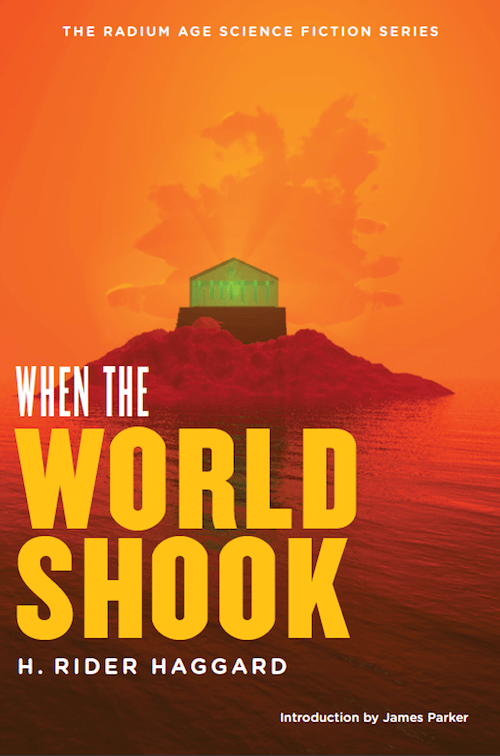
When the World Shook
By H. Rider Haggard
[ISBN: 978-1-935869-56-6; Library of Congress: 2012939658]
MARCH — AUGUST 2012
When adventurers Bastin, Bickley, and Arbuthnot are marooned on a South Sea island, they discover two Atlanteans in a state of suspended animation. One of the awakened sleepers, Lord Oro, is a superman — the last king of the Sons of Wisdom, who’d relied on hyper-advanced technology to subjugate the planet’s lesser peoples. The other is Oro’s sexy daughter, Yva… who falls in love with Arbuthnot. Using astral projection, Lord Oro visits London and the battlefields of the Western Front. Why? To determine whether or not he should once again employ an infernal chthonic machine to drown the worthless human race, as he’d done 250,000 years earlier!
The novel, which Rudyard Kipling helped plot, was first published in 1919.
H. Rider Haggard wrote some of the most popular adventure novels of all time, including King Solomon’s Mines and its sequel Allan Quatermain (one of the inspirations for George Lucas and Steven Spielberg’s Indiana Jones); and She and its sequel Ayesha.
“A really splendid romance, rich in color, fresh and gorgeous in its imaginative qualities and power, and needless to add, absorbingly interesting, is this wherein Rider Haggard tells us of what happened ‘When the World Shook.'” — The New York Times (1919)
“Speaking quite soberly and without exaggeration, this story of ‘When the World Shook’ is an amazing novel. Amazing in its imaginative quality, its romance, the splendor of its descriptions, doubly amazing when one remembers that it is the successor to a long series of colorful tales of adventure in savage or extraordinary lands… We frankly admit that, in our opinion at least, Rider Haggard has never conceived and placed before our eyes any pictures more thrilling or more impressive that are contained in this latest book.” — New York Evening Post (1919)
“Rider Haggard has again unbridled his splendid imagination. A thrilling, gigantic wonder tale.” — Pittsburgh Sun (1919)
“If this is pulp fiction it’s high pulp: a Wagnerian opera of an adventure tale, a B-movie humanist apocalypse and chivalric romance. When the World Shook has it all — English gentlemen of leisure, a devastating shipwreck, a volcanic tropical island inhabited by cannibals, an ancient princess risen from the grave, and if that weren’t enough a friendly, ongoing debate between a godless materialist and a devout Christian. H. Rider Haggard’s rich universe is both profoundly camp and deeply idealistic.” — Lydia Millet (2012 blurb for HiLoBooks)
Introduction by James Parker, author of Turned On: A Biography of Henry Rollins and a contributing editor at The Atlantic.
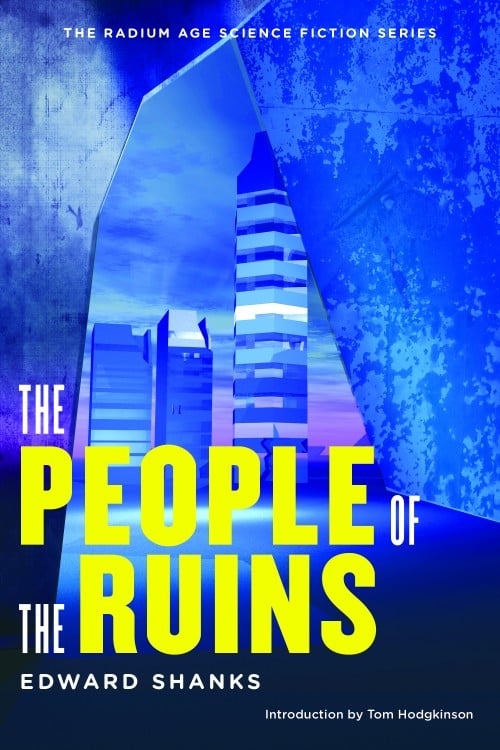
The People of the Ruins
By Edward Shanks
[ISBN: 978-1-935869-58-0; Library of Congress: 2012939659]
MAY — SEPTEMBER 2012
Trapped in a London laboratory during a worker uprising in 1924, scientist and ex-artilleryman Jeremy Tuft awakens 150 years later — on the eve of a new Dark Age! Though dismayed by the realization that his own era’s faith in the inevitability of progress was a shibboleth, Tuft decides that pre-modern life is simpler, more peaceful. That is, until half-savage northern English and Welsh tribes invade London… at which point he sets about reinventing twentieth century weapons of mass destruction.
Shanks’ proto-Idiocracy satire on William Morris-esque utopias was first published in 1920.
Edward Shanks was an English author, poet, critic, and journalist. He was editor of the literary journal Granta just before serving in World War I; he is perhaps best remembered today as a war poet. The People of the Ruins is his only science fiction novel.
“The first of the many British postwar novels that foresee Britain returned to barbarism by the ravages of war.” — Anatomy of Wonder, Neil Barron, ed. (1976)
“One of the most widely read scientific romances of the post-war years.” — Brian Stableford, Scientific Romance in Britain 1890-1950 (1985)
“After World War I British futuristic fiction was dominated by the idea that a new war could and probably would obliterate civilization…. Utopian speculation was not entirely stifled but undermined and opposed by cynicism.” — The Cambridge Guide to Literature in English, Ian Ousby, ed. (1996)
“A very good and a very interesting novel [which] can be read with pleasure both as a curiosity item and for its own sake.” — Tom Hodgkinson (2012)
Introduction by Tom Hodgkinson, editor of the British journal The Idler, and author of How To Be Idle, How To Be Free, and Brave Old World, among other titles.
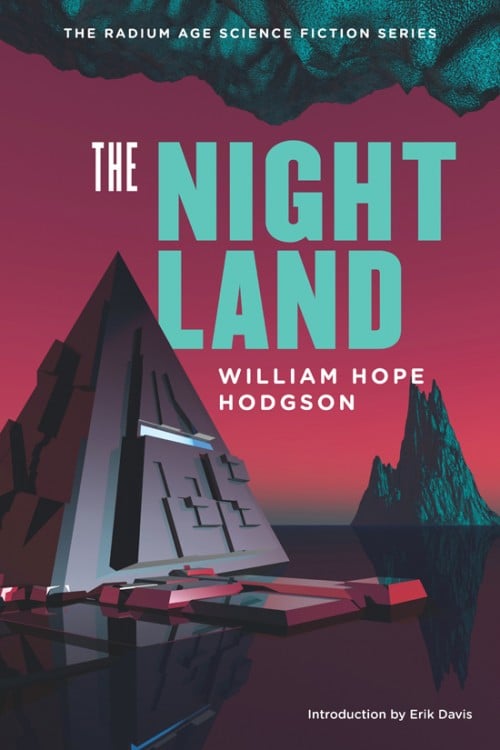
The Night Land
By William Hope Hodgson
[ISBN 978-1-935869-60-3; Library of Congress: 2012939660]
JUNE — OCTOBER 2012
In the far future, what remains of the human population dwells deep below the Earth’s frozen surface in a pyramidal fortress-city that for centuries has been surrounded by giants, “ab-humans,” enormous slugs and spiders, and malevolent Watching Things from an alien dimension. When the novel’s unnamed protagonist receives a telepathic distress signal from a young woman whom (in a previous incarnation) he’d once loved, he sallies forth on an ill-advised rescue mission — into the uncharted and unfathomable Night Land.
The Night Land was first published in 1912. The HiLoBooks edition omits two sections — a prefatory conceit, and a lengthy dénouement — which have helped prevent Hodgson’s masterpiece from reaching a wider audience.
William Hope Hodgson was an English poet, and author of horror, fantastic, and supernatural narratives — including a series of stories featuring the occult detective Thomas Carnacki, and the 1908 “weird supernatural” classic The House on the Borderland.
“One of the most potent pieces of macabre imagination ever written.” — H.P. Lovecraft, “Supernatural Horror in Literature” (1927)
“In all literature, there are few works so sheerly remarkable, so purely creative, as The Night Land… Only a great poet could have conceived and written this story; and it is perhaps not illegitimate to wonder how much of actual prophecy may have been mingled with the poesy… It is to be hoped that work of such unusual power will eventually win the attention and fame to which it is entitled.” — Clark Ashton Smith, “In Appreciation of William Hope Hodgson” (1944)
“[Good science fiction stories] give, like certain rare dreams, sensations we never had before, and enlarge our conception of the range of possible experience… W.H. Hodgson’s The Night Land [makes the grade] in eminence from the unforgettable sombre splendour of the images it presents…” — C.S. Lewis, “On Science Fiction” (1955)
“For all its flaws and idiosyncracies, The Night Land is utterly unsurpassed, unique, astounding. A mutant vision like nothing else there has ever been.” — China Miéville (2012 blurb for HiLoBooks)
Introduction by social historian and cultural critic Erik Davis, author of such books as TechGnosis: Myth, Magic, and Mysticism in the Age of Information and Nomad Codes.
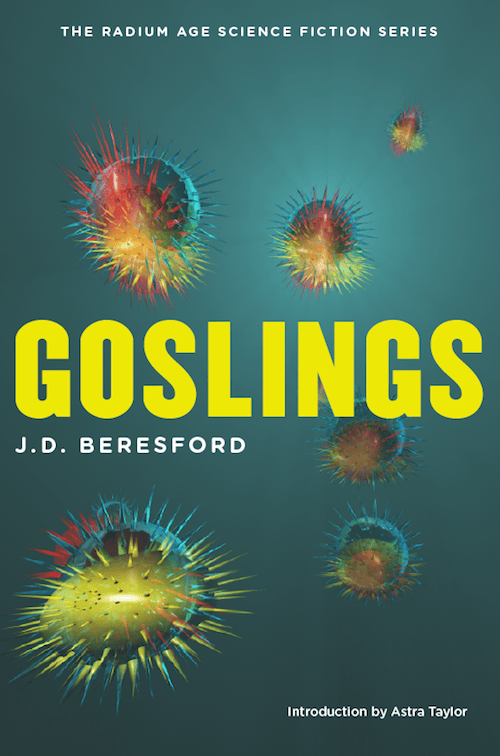
Goslings
By J.D. Beresford
[ISBN 978-1-935869-62-7; Library of Congress: 2013932536]
SEPTEMBER 2012 — MAY 2013
When a plague kills off most of England’s male population, the proper bourgeois Mr. Gosling abandons his family for a life of lechery. His daughters — who have never been permitted to learn self-reliance — in turn escape London for the countryside, where they find meaningful roles in a female-dominated agricultural commune. That is, until the Goslings’ idyll is threatened by their elders’ prejudices about free love!
J.D. Beresford was an English dramatist, journalist, and author. His science fiction novels include The Hampdenshire Wonder (1911) and The Riddle of the Tower (1944, with Esme Wynne-Tyson). His daughter Elisabeth was author of a series of children’s books about The Wombles.
Beresford’s friend the poet and novelist Walter de la Mare consulted on Goslings, which was first published in 1913. In May 2013, HiLoBooks will publish a beautiful centennial edition of this long-unattainable book.
“A fantastic commentary upon life.” — W.L. George, The Bookman (1914)
“The picture of that bevy of English Bacchantes — graceless civilized savages — dragging along a butcher in a triumphal car, cannot be forgotten — it is a piece of the most vivid imaginative realism, as well as a challenge to our vaunted civilization.” — The Living Age (1916)
“At once a postapocalyptic adventure, a comedy of manners, and a tract on sexual and social equality, Goslings is by turns funny, horrifying, and politically stirring. Most remarkable of all may be that it has not yet been recognized as a classic.” — Benjamin Kunkel (2012 blurb for HiLoBooks)
Introduction by Astra Taylor, a writer, political organizer, and director of the documentary films Žižek! and Examined Life.
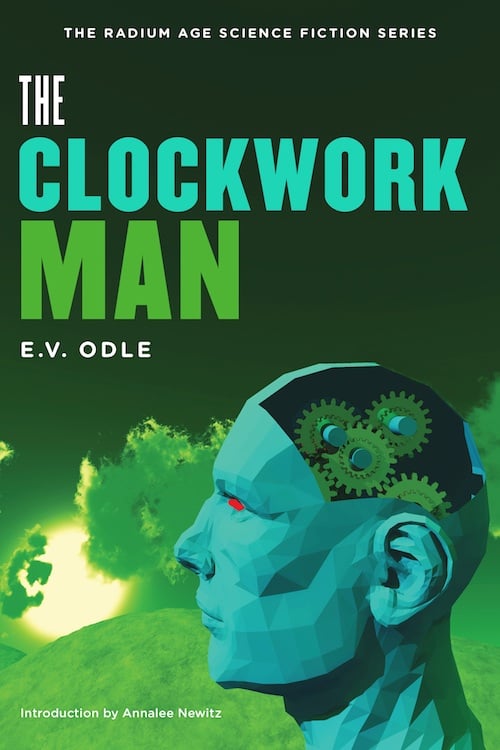
The Clockwork Man
By E.V. Odle
[ISBN 978-1-935869-63-4; Library of Congress: 2013932621]
MARCH 2013 — JULY 2013
Years from now, advanced beings known as the Makers will implant clockwork devices into our heads. At the cost of a certain amount of agency, these marvelous devices will permit us to move unhindered through time and space, and to live perfectly regulated lives. However, if one of these devices should ever go awry, a “clockwork man” from the future might turn up in the 1920s, perhaps at a cricket match in a small English village.
Rumors that “E.V. Odle” was a pen name for Virginia Woolf are amusing, but unfounded. Edwin Vincent Odle (1890–1942) was a playwright, critic, and short-story author who lived in Bloomsbury, London during the 1910s; his brother, Alan, was a well-known illustrator and eccentric. From 1925–35, he was editor of the British short-story magazine The Argosy.
Considered the original cyborg novel, The Clockwork Man was first published in 1923 — the same year as Karel Čapek’s pioneering android play, R.U.R. In September 2013, HiLoBooks will publish a beautiful 90th anniversary edition of this long-unattainable book.
“Edwin Vincent Odle’s ominous, droll, and unforgettable The Clockwork Man is a missing link between Lewis Carroll and John Sladek or Philip K. Dick,” says Jonathan Lethem in a 2013 blurb for HiLoBooks. “Considered with them, it suggests an alternate lineage for SF, springing as much from G.K. Chesterton’s sensibility as from H.G. Wells’s.”
“This is still one of the most eloquent pleas for the rejection of the ‘rational’ future and the conservation of the humanity of man,” writes Brian Stableford in Scientific Romance in Britain, 1890-1950. “Of the many works of scientific romance that have fallen into utter obscurity, this is perhaps the one which most deserves rescue.”
“Perhaps the outstanding scientific romance of the 1920s,” agrees the sci-fi reference book Anatomy of Wonder.
Introduction by Annalee Newitz, editor-in-chief of the science fiction and science blog io9. She’s the author of Scatter, Adapt, and Remember: How Humans Will Survive a Mass Extinction (2013) and Pretend We’re Dead: Capitalist Monsters in American Pop Culture (2006).
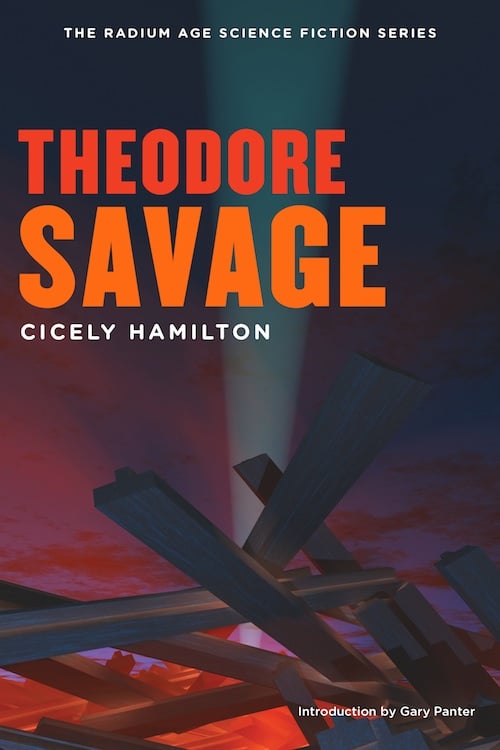
Theodore Savage
By Cicely Hamilton
[ISBN 978-1-935869-64-1; Library of Congress: 2013932623]
MARCH 2013 — AUGUST 2013
When war breaks out in Europe — modern, aerial war whose tactics include displacing entire populations — British civilization collapses overnight. The ironically named Theodore Savage, an educated and idle civil servant, must learn to survive by his wits in a new Britain… one where science and technology swiftly come to be regarded with superstitious awe and terror.
Cicely Hamilton (1872–1952) was an Anglo-Irish novelist, dramatist, and campaigner for women’s rights who served during WWI with an ambulance unit and at a military hospital in France. Her plays include Diana of Dobson’s (1908) and How the Vote was Won (1909); her 1909 treatise Marriage as a Trade is a witty criticism of that institution. The dystopian Theodore Savage is her only science fiction novel.
The book — by a women’s rights activist often remembered today for her polemical plays, tracts and treatises — was first published in 1922. In October 2013, HiLoBooks will publish a beautiful paperback edition of this long-unattainable book.
“Like Colson Whitehead’s Zone One without the zombie camp and idiom, Theodore Savage is a dark, strange, and cruelly contemporary tale of The Ruin and the post-apocalyptic condition that follows,” says Alexis Madrigal in a 2013 blurb for HiLoBooks. “The book makes a spirited argument against science and machines, disputing itself viciously to the last word.”
“Miss Hamilton always writes forcibly, and her present novel deals with the heart shaking effects of the next war. It might, indeed, be used as a tract to convey an awful warning.” — The Spectator (1922)
“A particularly effective and chilling version of a theme that dominates British speculative fiction between the wars.” — Anatomy of Wonder, Neil Barron, ed.
“Hamilton is one of the first — and among the darkest — of those UK novelists whose vision of things was shaped by WWI, which they saw as foretelling the end of civilization.” — The Encyclopedia of Science Fiction, Clute and Nicholls, eds.
Introduction by comics and design legend Gary Panter. Panter won three Emmy awards for his set designs for Pee-Wee’s Playhouse. His artistic activity includes the science fiction comics Jimbo and Dal Tokyo, painting, prose, music, and light shows. He teaches at School of Visual Arts in Manhattan.
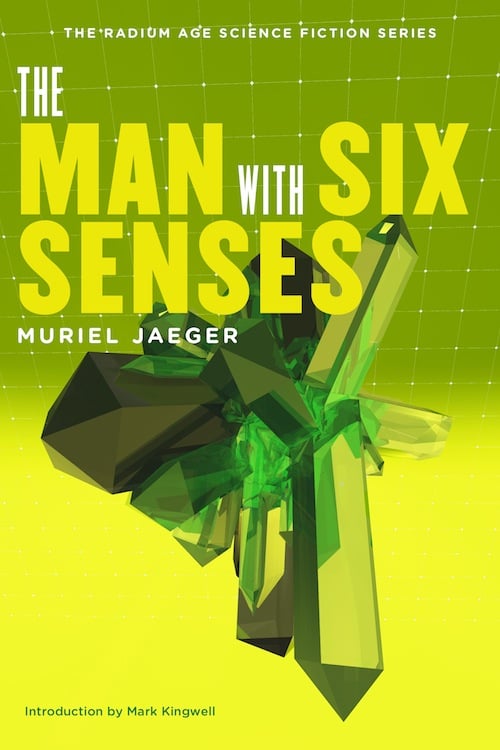
The Man with Six Senses
By Muriel Jaeger
[ISBN 978-1-935869-65-8; Library of Congress: 2013944931]
OUT OF PRINT — IT HAS COME TO OUR ATTENTION THAT THIS TITLE WAS NOT, IN FACT, IN THE PUBLIC DOMAIN
JULY 2013 — NOVEMBER 2013 (NO LONGER AVAILABLE)
When Hilda, a beautiful young member of England’s cynical postwar generation, meets Michael, a hapless mutant capable of perceiving the molecular composition of objects and the ever-shifting patterns of electromagnetic fields, she becomes his apostle. However, her efforts to convince others of the prodigy’s unique importance end disastrously; and Michael himself is slowly destroyed — mentally and physically — by his uncanny gift. In the end, Hilda must decide whether she is willing and able to make a supreme sacrifice for the sake of humankind’s future.
Muriel Jaeger (1892–1969) was a British historian and social critic (Before Victoria). Her science fiction books include The Question Mark (1926), an ambiguous utopia that likely influenced Aldous Huxley; Hermes Speaks (1933); and Retreat From Armageddon (1936).
This early and brilliant effort to export the topic of extra-sensory perception out of folklore and occult romances and import it into science fiction was first published in 1927 — by Leonard and Virginia Woolf’s Hogarth Press. In December 2013, HiLoBooks will publish a beautiful paperback edition of this long-unattainable book.
“A careful and sensitive novel about a youth who is attempting to develop and utilize a new mode of sensory perception.” — Anatomy of Wonder, Neil Barron, ed. (1995)
“The first attempt to extrapolate the hypothesis [of ESP] carefully and painstakingly — and to conclude that it might better be reckoned a curse than a blessing.” — The Encyclopedia of Science Fiction (3rd edition)
“What a treat to see how far the themes of textuality and telepathy reach back into the history of the science fiction genre, and in a novel by a gifted female writer published by Leonard and Virginia Woolf no less. A reason to celebrate.” — Jeffrey J. Kripal, author of Authors of the Impossible: The Paranormal and the Sacred (2013 blurb for HiLoBooks)
Introduction by Mark Kingwell, a professor of Philosophy at the University of Toronto. He is author or co-author of seventeen books of political, cultural and aesthetic theory, including Better Living (1998), The World We Want (2000), Concrete Reveries (2008), and Glenn Gould (2009). Kingwell’s most recent book, Unruly Voices (2012), is a collection of essays on politics.
Ongoing notes by HiLobrow and HiLoBooks editor Joshua Glenn
Published in part by BoingBoing (Feb. 14, 2012); and in part by the scientific journal Nature (September 13, 2012)

Several years ago, I read Brian Aldiss’s Billion Year Spree — his “true history of science fiction” from Mary Shelley to the early 1970s. I found Aldiss’s account of the genre’s development entertaining and informative… but something bothered me, long after I’d finished reading it. So much so that I’ve since spent hundreds of dollars on forgotten, out-of-print books; I’ve written dozens of long, scholarly posts about the thing that bothered me so much, for io9 and my own blog, HiLobrow; and this year I’ve even launched a money-losing publishing imprint in a quixotic effort to set the record straight.
Aldiss’s book is terrific on the topic of science fiction from Frankenstein through the “scientific romances” of Verne, Poe, and Wells — and also terrific on science fiction’s so-called Golden Age, the start of which he, like every other sf exegete, dates to John W. Campbell’s 1937 assumption of the editorship of the pulp magazine Astounding. However, regarding science fiction published between the beginning of the Golden Age and the end of the Verne-Poe-Wells “scientific romance” era, Aldiss (who rightly laments that Wells’s 20th century fiction after, perhaps, 1904’s The Food of the Gods, fails to recapture “that darkly beautiful quality of imagination, or that instinctive-seeming unity of construction, which lives in his early novels”) has very little to say. “Hm,” I thought, when I noticed that. “That’s an awfully long stretch of science fiction history to overlook, isn’t it?”
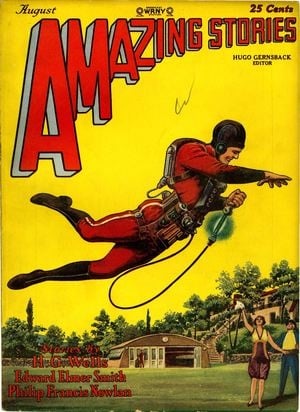
Aldiss seems to feel that authors of science fiction after Wells and before the Golden Age weren’t very talented. He doesn’t think much, for example, of the literary skills of Hugo Gernsback (sometimes called the “Father of Science Fiction”) who founded Amazing Stories in 1926 and coined the phrase “science fiction” while he was at it. True, Gernsback’s ideas were advanced, while his story-telling abilities were primitive. But does that really justify skipping over the 1900s through the mid-1930s? (PS: By my reckoning, Campbell and his cohort first began to develop their literate, analytical, socially conscious science fiction in reaction to the 1934 advent of the campy Flash Gordon comic strip, not to mention Hollywood’s innumerable mid-1930s Bug-Eyed Monster-heavy “sci-fi” blockbusters that sought to ape the success of 1933’s King Kong. They were also no doubt influenced by the 1932 publication of Aldous Huxley’s Brave New World. In other words, the Golden Age began before 1937; if I had to choose a year, I’d say 1934.) Is Aldiss’s animus against that era due solely to style and quality? I suspect not. Billion Year Spree reminds me of one of those airbrushed Soviet-era photos from which an embarrassing historical fact has been excised.
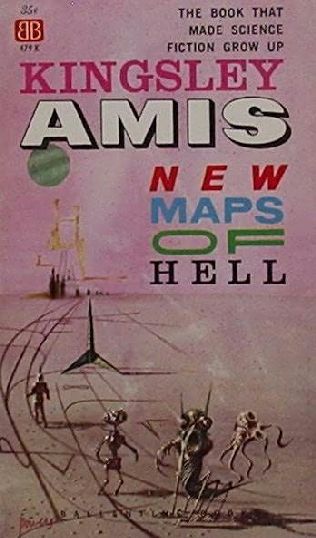
I read several other histories of science fiction, and looked at sf timelines, and discovered that Aldiss was hardly alone in sweeping pre-Golden Age science fiction under the rug. During the so-called Golden Age, which was given that moniker not after the fact, but at the time, as a way of signifying the end of science fiction’s post-Wells Dark Age, Campbellians took pains to distinguish their own science fiction from everything that had been published in the genre, with the sole exception of Brave New World, since 1904. In his influential 1958 critique, New Maps of Hell, for example, Kingsley Amis noted that mature science fiction first established itself in the mid-1930s, “separating with a slowly increasing decisiveness from [immature] fantasy and space-opera.” Aldous Huxley claimed: “Rooted as they are in the facts of contemporary life, the phantasies of even a second-rate writer of modern Science Fiction are incomparably richer, bolder, and stranger than the Utopian or Millennial imaginings of the past.” And in his introduction to a 1974 collection, Before the Golden Age, editor Isaac Asimov condescendingly notes that although it certainly possessed an exuberant vigor, the pre-Golden Age science fiction he grew up reading “seems, to anyone who has experienced the Campbell Revolution, to be clumsy, primitive, naive.”
We should be suspicious of this Cold War-era rhetoric of maturity! I’m reminded of Reinhold Niebuhr’s pronunciamento, at a 1952 Partisan Review symposium, that the widespread utopianism of the early 20th century ought to be regarded as “an adolescent embarrassment.” Perhaps Golden Age science fiction’s brightest lights — Asimov, Robert Heinlein, Andre Norton, Clifford D. Simak, C.L. Moore, Ray Bradbury, Frederik Pohl, and so forth — were regarded as an improvement on their predecessors because in their stories utopian visions and schemes were treated with skepticism and cynicism. Brilliant anti-utopians like Niebuhr, Isaiah Berlin, Hannah Arendt, and Karl Popper were right to point out that pre-Cold War utopian narratives often demonstrated a naive and perhaps proto-totalitarian eagerness to force square pegs into round holes via thought control and coercion. However, I agree with those who argue that the intellectual abandonment of utopianism since the late 1930s has sapped our political options, and left us all in the helpless position of passive accomplices.
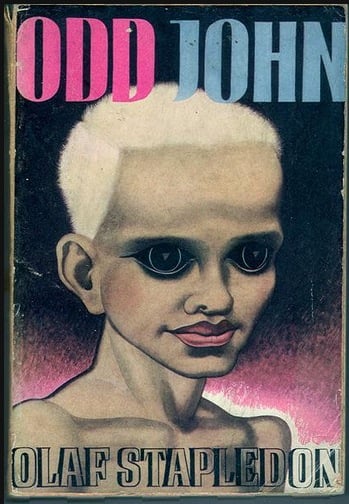
This rhetoric of maturity versus immaturity has been parroted by science fiction historians ever since. “By the early 1940s the SF field had come into being….” recounts David G. Hartwell in his introduction to the 1997 collection The Science Fiction Century. “In its own view, science fiction had already grown up, in Campbell’s Astounding: the 1940s were the Golden Age of SF.” He goes on to describe science fiction of the 1920s and 1930s as “almost plotless stories of zipping through the ether in spaceships, meeting aliens, using futuristic devices, and fighting the bad guys (and winning). SF people generally call this sci-fi (affectionately, ‘skiffy’), to distinguish it from the real, grown-up pure quill.” You get the idea.
So did so-called Golden Age science fiction actually succeed a Dark Age for science fiction? I don’t think so. Golden Age science fiction authors and propagandists grew up reading science fiction from the 1904-33 era; it’s from that era, as I’ve discovered in my own reading, that we have inherited such enduring science fiction tropes as the superman, the eco-catastrophe, robots, and the telepath! Sure, some 1904-33 science fiction — Gernsback, Edgar Rice Burroughs, and E.E. “Doc” Smith, for example — is indeed fantastical and primitive (though it’s still fun to read today). But many other European and American science fiction authors of that period — including Olaf Stapledon, William Hope Hodgson, Karel Čapek, Charlotte Perkins Gilman, and Yevgeny Zamyatin — gave us science fiction that was literate, analytical, socially conscious… and also utopian. Whatever their politics, authors writing from 1904-33 found in science fiction a fitting vehicle to express their faith, or at least their hope, that another world is possible. That worldview may have seemed embarrassingly adolescent from the late 1930s until, say, the fall of the Berlin Wall. But today it’s an inspiring vision.
I’ve tracked down scores of forgotten science fiction novels and stories from 1904-33. I’ve concluded that it’s an era of which science fiction historians and fans ought to be proud! I’ve dubbed this unfairly overlooked era science fiction’s “Radium Age” because the era saw the rise of nuclear physics and the revelation that the familiar — matter itself — is strange, even alien. (“No subversive radium speculations had shaken his steady scientific faith in the conservation of energy and the indestructibility of matter.” — from Jack London’s 1918 science fiction story “The Red One.”) The 1896 discovery of radioactivity, which led to the early twentieth-century insight that the atom is, at least in part, a state of energy, constantly in movement, is the perfect metaphor for an era in which old scientific, religious, political, and social certainties were subverted and shattered. Plus, “Radium Age” is a great phrase.

As demonstrated by Philipp Blom in The Vertigo Years: Europe 1900–1914, the actual experience of time and space was altered in this period by the proliferation of a range of stunning technological developments, from the telegraph and the telephone to aeroplanes and cinematic film. Thinking and perception were radically reoriented by developments in science, philosophy and the arts. These included Einstein’s special theory of relativity; the work of phenomenological philosophers such as Edmund Husserl, who sought to objectively describe the subjective workings of consciousness; and Cubism, the artistic movement spearheaded by Pablo Picasso and Georges Braque that explored distortion and deconstruction. Social and cultural forms and norms, such as women’s subordination to men — once regarded as natural, permanent ‘elements’ — were disintegrating.
During this astonishing period, sci-fi writers were obsessed with the future. The scientific romantics had conjured up simplistic utopias that remained firmly grounded in contemporary realities. By contrast, science fiction’s Radium Age novels, stories, movies and plays often lift off into previously unexplored realms.
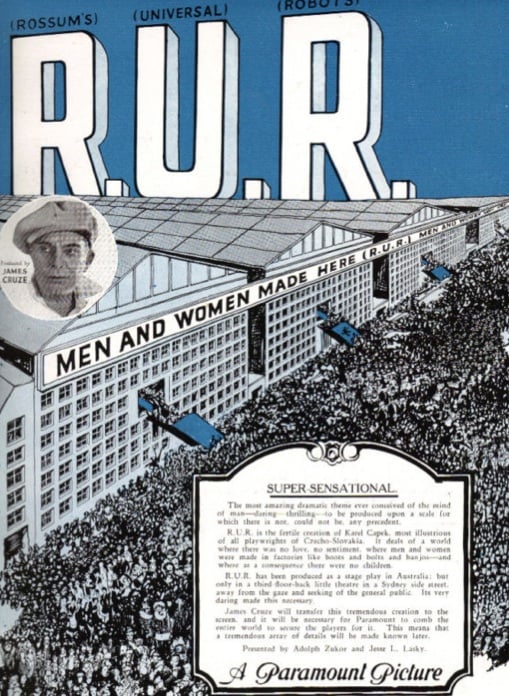
Instead of offering progressive solutions to social unrest, writers satirized and exaggerated its causes and effects. The out-of-control robot can be read as a criticism of the efficiency-oriented theories of Frederick Winslow Taylor and the practices of industrialist Henry Ford. So R.U.R. (Czechoslovakian writer Karel Čapek’s 1920 play, which introduced the term “robot” to the English language) portrays mass production as alienating at best. In Jack London’s post-apocalyptic The Scarlet Plague (1912), a race of barbarians descended from San Francisco’s brutalized underclass roam the city’s devastated remains after the fatal pandemic of 2013. And Charlotte Perkins Gilman’s feminist novel Herland (1915) imagines an ideal community in which women aren’t merely emancipated, but have done away with men altogether.
Politics are inevitably part of the mix — this is an era that encompassed the First World War, the Russian revolutions, and the rise of radical left- and right-wing movements. Many sci-fi authors, such as Čapek and Yevgeny Zamyatin, were leftists and liberals. But more conservative authors shared their utopianism and cynicism. For instance, Arthur Conan Doyle, inventor of Sherlock Holmes, wrote a series of ripping yarns starring a Professor Challenger, who discovers surviving dinosaurs, travels to Earth’s “sensory cortex” and (in The Poison Belt) witnesses the end of life on the planet — all the while making the case for reconciling imagination and intuition with a skeptical scientific method.
Similarly, H. Rider Haggard, who had made his name with King Solomon’s Mines and the Quartermain novels of the 1880s, created a disputatious trio in 1919’s When the World Shook — an idealistic Anglican minister, a sardonic doctor and an adventurer whose world view hovers somewhere in between. Meanwhile, both the leftist London (in The Scarlet Plague) and the conservative English poet Edward Shanks (in The People of the Ruins) agree that the destruction of modern western society wouldn’t be an entirely bad thing.
Fans of Philip K. Dick or Ursula K. Le Guin — writers belonging to what literary theorist Fredric Jameson has termed the “anti-anti-utopian” trend of the late 1960s and early 1970s — will find provocative antecedents here. Reading the dangerous visions of Radium Age sci-fi, published in times as volatile as our own, destabilizes everything we take for granted. These books remind us that we need to regard our twenty-first-century forms and norms without sentimentality.
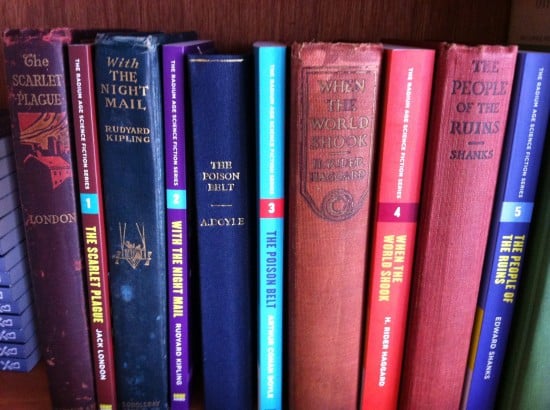
MORE RADIUM AGE SCI FI ON HILOBROW: HiLoBooks homepage! | What is Radium Age science fiction? |Radium Age 100: 100 Best Science Fiction Novels from 1904–33 | Radium Age Supermen | Radium Age Robots | Radium Age Apocalypses | Radium Age Telepaths | Radium Age Eco-Catastrophes | Radium Age Cover Art (1) | SF’s Best Year Ever: 1912 | Radium Age Science Fiction Poetry | Enter Highbrowism | Bathybius! Primordial ooze in Radium Age sf | War and Peace Games (H.G. Wells’s training manuals for supermen) | Radium Age: Context series | J.D. Beresford | Algernon Blackwood | Edgar Rice Burroughs | Karel Čapek | Buster Crabbe | August Derleth | Arthur Conan Doyle | Hugo Gernsback | Charlotte Perkins Gilman | Cicely Hamilton | Hermann Hesse | William Hope Hodgson | Aldous Huxley | Inez Haynes Irwin | Alfred Jarry | Jack Kirby (Radium Age sf’s influence on) | Murray Leinster | Gustave Le Rouge | Gaston Leroux | David Lindsay | Jack London | H.P. Lovecraft | A. Merritt | Maureen O’Sullivan | Sax Rohmer | Paul Scheerbart | Upton Sinclair | Clark Ashton Smith | E.E. “Doc” Smith | Olaf Stapledon | John Taine | H.G. Wells | Jack Williamson | Stanisław Ignacy Witkiewicz | S. Fowler Wright | Philip Gordon Wylie | Yevgeny Zamyatin
ALSO: See our list of the 100 Best Radium Age Science Fiction Novels.
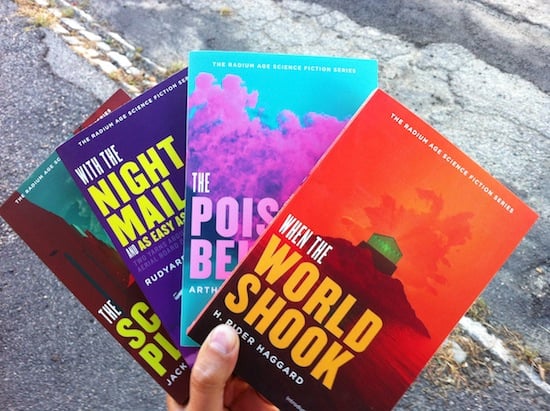
SERIALIZED BY HILOBOOKS: Jack London’s The Scarlet Plague | Rudyard Kipling’s With the Night Mail (and “As Easy as A.B.C.”) | Arthur Conan Doyle’s The Poison Belt | H. Rider Haggard’s When the World Shook | Edward Shanks’ The People of the Ruins | William Hope Hodgson’s The Night Land | J.D. Beresford’s Goslings | E.V. Odle’s The Clockwork Man | Cicely Hamilton’s Theodore Savage | Muriel Jaeger’s The Man With Six Senses | Jack London’s “The Red One” | Philip Francis Nowlan’s Armageddon 2419 A.D. | Homer Eon Flint’s The Devolutionist | W.E.B. DuBois’s “The Comet” | Edgar Rice Burroughs’s The Moon Men | Charlotte Perkins Gilman’s Herland | Sax Rohmer’s “The Zayat Kiss” | Eimar O’Duffy’s King Goshawk and the Birds | Frances Hodgson Burnett’s The Lost Prince | Morley Roberts’s The Fugitives | Helen MacInnes’s The Unconquerable | Geoffrey Household’s Watcher in the Shadows | William Haggard’s The High Wire | Hammond Innes’s Air Bridge | James Branch Cabell’s Jurgen | John Buchan’s “No Man’s Land” | John Russell’s “The Fourth Man” | E.M. Forster’s “The Machine Stops” | John Buchan’s Huntingtower | Arthur Conan Doyle’s When the World Screamed | Victor Bridges’ A Rogue By Compulsion | Jack London’s The Iron Heel | H. De Vere Stacpoole’s The Man Who Lost Himself | P.G. Wodehouse’s Leave It to Psmith | Richard Connell’s “The Most Dangerous Game” | Houdini and Lovecraft’s “Imprisoned with the Pharaohs” | Arthur Conan Doyle’s “The Sussex Vampire” | John W. Campbell’s “The Last Evolution”.
LIT LISTS FROM HILOBROW’s JOSHUA GLENN: 200 Greatest Adventure Novels (1804–1983) | Best Adventure Novels (1984–2013, notes only) | 100 Best Radium Age Sci-Fi Novels (1904–1933) | 75 Best Golden Age Sci-Fi Novels (1934–1963) | 75 Best New Wave Sci-Fi Novels (1964–1983) | 75 Best Diamond Age Sci-Fi Novels (1984–2003) | 55 Best Scientific Romances (1864–1903) | Best 19th Century Adventure (1805–1903) | 101 Science Fiction Adventures | 70 Crime Adventures | 65 Fantasy Adventures | 61 Espionage Adventures | 40 Atavistic & Historical Adventures | 25 Frontier & Western Adventures | 20 Avenger & Artful Dodger Adventures | 20 Apophenic & Treasure Hunt Adventures | 20 War & Ruritanian Adventures | 18 Picaresque Adventures | 10 Robinsonade & Survival Adventures. ALSO: BEST SIXTIES YA & YYA (1964–1973) | THE OUGHTS: 1904 | 1905 | 1906 | 1907 | 1908 | 1909 | 1910 | 1911 | 1912 | 1913. THE TEENS: 1914 | 1915 | 1916 | 1917 | 1918 | 1919 | 1920 | 1921 | 1922 | 1923. THE TWENTIES: 1924 | 1925 | 1926 | 1927 | 1928 | 1929 | 1930 | 1931 | 1932 | 1933. THE THIRTIES: 1934 | 1935 | 1936 | 1937 | 1938 | 1939 | 1940 | 1941 | 1942 | 1943. THE FORTIES: 1944 | 1945 | 1946 | 1947 | 1948 | 1949 | 1950 | 1951 | 1952 | 1953. THE FIFTIES: 1954 | 1955 | 1956 | 1957 | 1958 | 1959 | 1960 | 1961 | 1962 | 1963. THE SIXTIES: 1964 | 1965 | 1966 | 1967 | 1968 | 1969 | 1970 | 1971 | 1972 | 1973. THE SEVENTIES: 1974 | 1975 | 1976 | 1977 | 1978 | 1979 | 1980 | 1981 | 1982 | 1983. THE EIGHTIES: 1984 | 1985 | 1986 | 1987 | 1988 | 1989 | 1990 | 1991 | 1992 | 1993. THE NINETIES: 1994 | 1995 | 1996 | 1997 | 1998 | 1999 | 2000 | 2001 | 2002 | 2003. I’ve only recently started taking notes towards a list of the Best Adventures of the EIGHTIES, NINETIES, and TWENTY-OUGHTS. | Best Scottish Fabulists | Radium-Age Telepath Lit | Radium Age Superman Lit | Radium Age Robot Lit | Radium Age Apocalypse Lit | Radium Age Eco-Catastrophe Lit | Radium Age Cover Art (1) | SF’s Best Year Ever: 1912 | Cold War “X” Fic | Best YA Sci-Fi | Hooker Lit | No-Fault Eco-Catastrophe Lit | Scrabble Lit |
